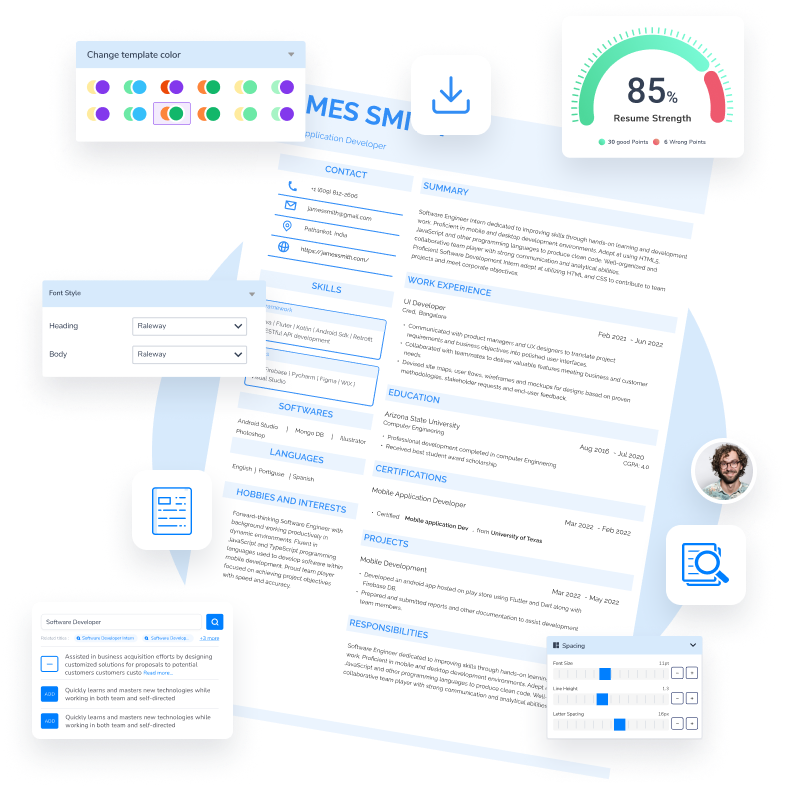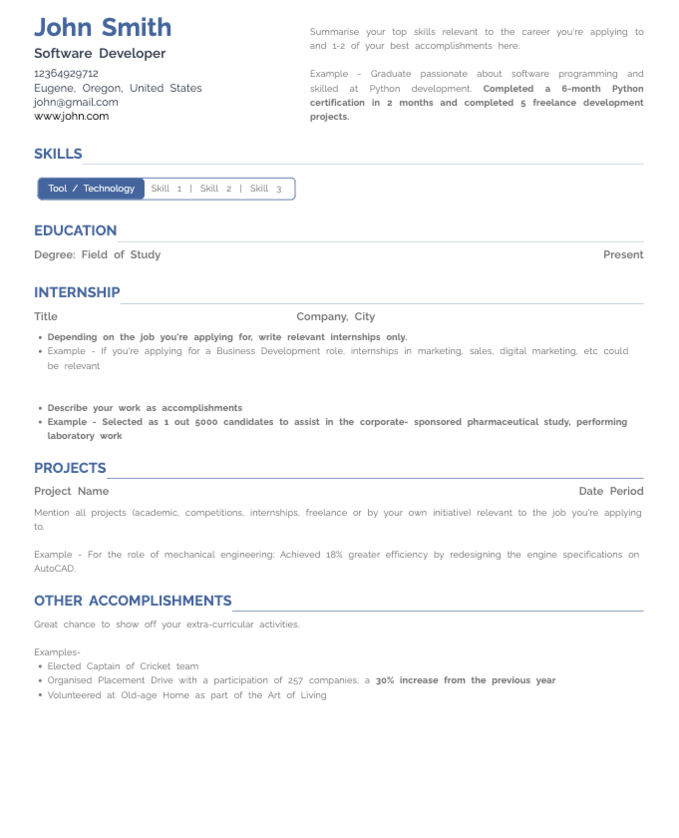10+ Tips to Build a Resume for Cybersecurity Jobs in 2023
7 min read

Are you building a resume for cybersecurity jobs in 2023?
If yes, this guide will help you frame it professionally.
Building a career in cybersecurity is not a piece of cake. It will require a lot of learning, practice, certifications, and a professional cybersecurity resume.
Here we are answering the fundamental questions to build a job-winning cybersecurity resume after learning all the cybersecurity skills. Our focus here includes the following:
- What are the cybersecurity profiles to apply for in 2023?
- What are the fundamental responsibilities of a cybersecurity professional?
- How does a cybersecurity job description help you while building a resume?
- What are the suitable resume formats for cybersecurity professionals?
- How to build a resume for cybersecurity jobs?
You can build an impactful cybersecurity resume by following these below-mentioned points easily. However, developing the final version of your cybersecurity resume will take time.
If you are running out of time, check out HyreSnap Online Resume Builder. It will help you craft an ATS-friendly cybersecurity resume in 10-15 minutes.
Let us now move ahead, considering that you have a lot of time to build a cybersecurity resume on your own:
The field of cybersecurity offers a wide range of job profiles due to the increasing importance of protecting digital assets and information. Here are some common cybersecurity job profiles available in the current job market:
- Cybersecurity Analyst: Monitors and analyses security incidents, investigates potential threats, and implements security measures to protect systems and networks.
- Security Engineer: Designs, implements, and maintains security systems and infrastructure, including firewalls, encryption methods, and intrusion detection systems.
- Penetration Tester: Conducts controlled simulated attacks on systems to identify vulnerabilities and weaknesses, and provides recommendations for improving security.
- Security Consultant: Advises organisations on their overall security posture, performs risk assessments, and develops security strategies and policies.
- Incident Responder: Investigates and responds to security incidents, analyses the impact, mitigates the damage, and implements measures to prevent future incidents.
- Security Architect: Designs and oversees the implementation of secure network architectures and systems, considering factors such as access controls, authentication mechanisms, and encryption methods.
- Threat Intelligence Analyst: Identifies and analyses emerging cybersecurity threats, collects and interprets data to provide actionable insights, and contributes to the development of proactive security measures.
- Cryptographer: Develops cryptographic algorithms, protocols, and systems to secure data transmission and storage, and ensures the confidentiality, integrity, and authenticity of information.
- Security Operations Center (SOC) Analyst: Monitors security systems, analyses alerts, investigates security incidents, and responds to threats in real time to maintain the security of an organisation's infrastructure.
- Security Auditor: Conducts assessments and audits of an organisation's security systems, policies, and procedures to ensure compliance with regulations and industry best practices.
- Digital Forensics Analyst: Collects and analyses digital evidence related to cybercrime or security breaches, and assists in incident response and legal proceedings.
- Security Manager: Oversees the planning, implementation, and management of an organisation's security program, including policy development, risk assessment, and incident response.
These are just a few examples of the diverse range of cybersecurity job profiles available in the current job market. Each role requires specific skills and expertise, and the demand for cybersecurity professionals continues to grow as organisations prioritise protecting their digital assets from evolving threats.
Cybersecurity professionals protect digital systems, networks, and data from unauthorised access, cyber threats, and potential breaches. Here are some fundamental responsibilities of cybersecurity professionals:
- Security Monitoring: Monitor and analyse systems, networks, and applications for potential security vulnerabilities, anomalies, and threats. This includes monitoring logs, alerts, and security tools to identify and respond to security incidents.
- Vulnerability Management: Conduct regular vulnerability assessments and penetration testing to identify weaknesses and vulnerabilities in systems and networks. Develop and implement strategies to remediate and mitigate these vulnerabilities.
- Incident Response: Respond promptly to security incidents, investigate the causes, and take appropriate actions to contain, mitigate, and recover from the incident. This involves coordinating with relevant stakeholders, documenting the incident, and implementing measures to prevent future occurrences.
- Security Architecture: Design, implement, and maintain a secure architecture for systems, networks, and applications. This includes configuring and managing firewalls, intrusion detection systems, access controls, and encryption methods to protect against unauthorised access and data breaches.
- Security Policies and Procedures: Develop, implement, and enforce security policies, standards, and procedures to ensure compliance with industry regulations and best practices. Educate and train employees on security awareness and best practices to foster a culture of security.
- Risk Assessment and Management: Conduct risk assessments to identify potential security risks, analyse the impact of those risks, and develop strategies to mitigate them. Regularly review and update risk management strategies to adapt to evolving threats and technologies.
- Security Awareness and Training: Develop and deliver security awareness programs and training sessions to educate employees about security threats, best practices, and their role in maintaining a secure environment. Promote a culture of security awareness throughout the organisation.
- Security Incident Reporting and Documentation: Maintain accurate records of security incidents, their resolution, and lessons learned. Generate reports and documentation for management and stakeholders to provide insights into the security posture and recommend improvements.
- Compliance and Regulations: Stay up-to-date with relevant laws, regulations, and industry standards related to cybersecurity. Ensure that systems, processes, and procedures comply with applicable regulations and assist in regulatory audits and assessments.
- Security Research and Awareness: Stay abreast of the latest trends, techniques, and emerging threats in the cybersecurity landscape. Engage in continuous learning, research, and professional development to enhance skills and knowledge.
These responsibilities may vary depending on the specific job role and the organisation's size, industry, and security requirements.
A job description can help you enhance your resume’s performance during recruitment. You will get many profile-centric keywords in your respective job description that you can use while building your resume.
It will help you parse through the ATS screening without any hassle. Moreover, reading a job description will clear all the confusion regarding the job responsibilities in your mind. To help you understand better, we have listed an example cybersecurity job description below and highlighted the keywords.
Example Cybersecurity Job Description:
TCL Technologies, a leading technology solutions provider, is seeking a talented and experienced Cybersecurity Professional to join our dynamic team. As a cybersecurity professional, you will play a crucial role in ensuring the security and integrity of our systems, networks, and data. You will have the opportunity to work with cutting-edge technologies and collaborate with a team of skilled professionals in a fast-paced and challenging environment.
Responsibilities:
>Implement and maintain robust cybersecurity measures to protect our systems, networks, and data from potential threats, vulnerabilities, and breaches.
>Monitor and analyse security logs, alerts, and reports to identify and respond to security incidents promptly.
>Conduct regular vulnerability assessments and penetration testing to identify weaknesses in our infrastructure and develop strategies to address them.
>Collaborate with cross-functional teams to design and implement secure network architectures, access controls, and encryption methods.
>Develop and enforce security policies, standards, and procedures to ensure compliance with industry regulations and best practices.
>Stay up-to-date with the latest cybersecurity trends, threats, and technologies, and make recommendations to enhance our security posture.
>Conduct security awareness programs and training sessions to educate employees on security best practices and promote a culture of security awareness.
>Participate in incident response activities, including containment, mitigation, and recovery, and document lessons learned for continuous improvement.
>Collaborate with internal and external stakeholders to assess and manage security risks and provide recommendations for risk mitigation.
Qualifications:
>Bachelor's degree in Computer Science, Information Security, or a related field. Relevant certifications such as CISSP, CISM, or CEH are preferred.
>Proven experience working in a cybersecurity role, with a deep understanding of security principles, best practices, and technologies.
>Strong knowledge of network security, firewalls, intrusion detection systems, and access controls.
>Experience with vulnerability assessment tools, penetration testing techniques, and risk assessment methodologies.
>Familiarity with security frameworks such as NIST, ISO 27001, or CIS Controls.
>Excellent analytical and problem-solving skills, with the ability to think strategically and handle complex security issues.
>Strong communication and interpersonal skills, with the ability to effectively collaborate with cross-functional teams and stakeholders.
>Up-to-date knowledge of cybersecurity regulations, laws, and compliance requirements.
When applying for a cybersecurity professional position, choosing a resume format that effectively showcases your skills, qualifications, and relevant experience is important.
Here are three suitable resume formats for cybersecurity professionals:
Chronological Resume Format
The chronological resume format is the most common and straightforward format. It highlights your work experience in reverse chronological order, starting with your most recent role. This format is suitable if you have a consistent work history in the cybersecurity field and want to emphasise your career progression and accomplishments. Include sections such as:
- Header
- Contact information
- Professional summary or objective statement
- Skills summary (highlighting your key cybersecurity skills)
- Technical skills
- Work experience (with bullet points describing your roles, responsibilities, and achievements)
- Education
- Certifications and professional development
- References (optional)
Functional Resume Format
The functional resume format focuses on your skills and abilities rather than emphasising your work history. This format is suitable if you have transferable skills or relevant experiences from various roles or industries. Use this format to highlight your cybersecurity skills and accomplishments. Include sections such as:
- Header
- Contact information
- Professional summary or objective statement
- Skills summary (organised by cybersecurity skills categories such as network security, vulnerability management, incident response, etc.)
- Technical skills
- Work experience (concise descriptions of roles and organisations without emphasising dates)
- Education
- Accomplishments and achievements (highlighting specific projects or initiatives where you demonstrated your cybersecurity skills)
- Certifications and professional development
- References (optional)
Combination Resume Format
The combination resume format combines elements of both the chronological and functional formats. It highlights both your skills and work history. This format is suitable if you want to showcase your cybersecurity skills while also providing a comprehensive overview of your relevant work experience. Include sections such as:
- Header
- Contact information
- Professional summary or objective statement
- Skills summary (emphasising your cybersecurity skills)
- Technical skills
- Work experience (highlighting relevant roles, responsibilities, and achievements)
- Education
- Accomplishments and skills (further showcasing your cybersecurity achievements)
- Certifications and professional development
- References (optional)
Remember to tailor your resume to the specific job description, emphasising the skills and experiences most relevant to the position you're applying for.
Use clear and concise language, quantify your achievements whenever possible, and proofread your resume for errors or inconsistencies.
Additionally, consider including a cover letter to further highlight your interest and suitability for the cybersecurity role.
Building a strong resume for a cybersecurity job requires careful attention to detail and a focus on highlighting your relevant skills, experiences, and qualifications. Here are some tips to help you create an effective resume for cybersecurity jobs:
- Choose the Right Resume Format: Select a format that best showcases your skills and experiences.
- Tailor Your Resume to the Job: Carefully review the job description and requirements of the cyber security position you're applying for. Customise your resume to align with those specific qualifications and highlight relevant skills and experiences.
- Include a Strong Summary/Objective Statement: Start your resume with a concise summary or objective statement that highlights your career goals, key skills, and relevant experience. Make it attention-grabbing and tailored to the position.
- Highlight Your Cyber Security Skills: Create a dedicated section emphasising your skills. Include technical skills such as network security, incident response, vulnerability management, risk assessment, and other relevant areas of expertise. Use bullet points for clarity and provide specific examples of how you've applied these skills.
- Showcase Your Experience: Detail your work experience, focusing on positions related to cyber security or roles where you've gained relevant skills. Include the company name, job title, and employment dates, and provide concise bullet points highlighting your responsibilities, achievements, and contributions in each role.
- Quantify Your Achievements: Wherever possible, quantify your accomplishments to demonstrate the impact you've made. For example, mention the number of successful security incidents resolved, the percentage of vulnerabilities mitigated, or the network size you managed.
- Include Relevant Certifications and Education: List your academic qualifications, including degrees, certifications, and relevant training programs. Highlight any industry-recognized certifications such as CISSP, CISM, CEH, or others that showcase your expertise in cyber security.
- Showcase Projects and Achievements: If you've worked on specific cybersecurity projects or initiatives, highlight them in a dedicated section. Explain your role, the challenges faced, and the outcomes achieved. This can help demonstrate your hands-on experience and problem-solving abilities.
- Demonstrate Continuous Learning: In the field of cyber security, it's important to showcase your commitment to ongoing learning and staying up-to-date with the latest industry trends. Include any relevant workshops, conferences, or training programs you've attended.
- Proofread and Edit: Ensure your resume is error-free by carefully proofreading for grammar, spelling, and formatting mistakes. Ask a friend or colleague to review it as well to catch any overlooked errors.
- Use a Professional Layout: Maintain a clean and professional layout for your resume. Use bullet points, clear headings, and consistent formatting to make it easy to read. Avoid excessive colours or graphics that may distract from the content.
- Include a Cover Letter: Consider including a tailored cover letter to introduce yourself, express your interest in the position, and provide additional context for your qualifications and experiences.
Remember, a well-crafted resume should be concise, focused, and tailored to the specific cybersecurity job you're applying for.
It should effectively demonstrate your skills, experiences, and qualifications, making a strong case for why you are the right candidate for the role.
We have listed an example resume for cybersecurity jobs that you can refer to while building your cybersecurity resume in 2023:
Example Resume For CyberSecurity Jobs:
Tanya Sharma
Ph No.- +919382648296
Email- tanya@hyresnap.com
LinkedIn- https://www.linkedin.com/in/tanya-sharma-a36559122/
Objective:
Highly motivated and skilled cybersecurity professional with a strong passion for securing digital assets and mitigating cyber threats. Seeking a challenging position in cybersecurity to utilise my expertise in network security, incident response, and vulnerability management to safeguard organisations from evolving cyber risks.
Education:
Bachelor of Science in Computer Science
XYZ University, City, State
Year of Graduation: [Year]
Certifications:
- Certified Information Systems Security Professional (CISSP)
- Certified Ethical Hacker (CEH)
- Certified Information Security Manager (CISM)
Skills:
- Network Security
- Incident Response
- Vulnerability Management
- Risk Assessment
- Intrusion Detection Systems (IDS)
- Security Information and Event Management (SIEM)
- Firewall Configuration and Administration
- Penetration Testing
- Threat Intelligence
- Secure Coding Practices
- Encryption Technologies
- Compliance and Regulatory Standards (e.g., GDPR, HIPAA)
Experience:
Cyber Security Analyst
ABC Corporation, City, State
[Employment Dates]
- Monitored and analysed security logs, alerts, and reports to detect and respond to security incidents promptly.
- Conducted regular vulnerability assessments and penetration testing to identify weaknesses and recommend appropriate remediation measures.
- Collaborated with cross-functional teams to design and implement robust security controls, including firewall configurations, access controls, and encryption methods.
- Assisted in incident response activities, ensuring timely containment, mitigation, and recovery from security incidents.
- Developed and enforced security policies and procedures, ensuring compliance with industry regulations and best practices.
- Provided security awareness training to employees, promoting a culture of security awareness and best practices.
Technical Support Specialist
DEF Company, City, State
[Employment Dates]
- Assisted users in troubleshooting and resolving technical issues related to network connectivity, software installations, and hardware configurations.
- Implemented security measures such as antivirus software, firewalls, and email filters to protect against malware and unauthorised access.
- Conducted regular backups of critical data and performed data recovery when necessary.
- Assisted in the planning and execution of security audits and assessments.
Projects and Achievements:
- Led a successful incident response team in mitigating a critical security breach, minimising the impact and preventing further damage.
- Developed and implemented a comprehensive vulnerability management program, reducing the number of high-risk vulnerabilities by 30%.
- Created and delivered a series of cybersecurity training sessions for employees, resulting in improved security awareness and reduced security incidents.
References:
Available upon request
You can craft a highly impactful resume for cybersecurity jobs by following these above-given guidelines. However, you must remember that it will take time to craft and polish the final version of your resume.
If you urgently need a cybersecurity resume, we recommend using HyreSnap Online Resume Builder. It comes with the following features to ease the resume-building process:
You can follow these guidelines to craft an impactful resume for cybersecurity jobs. Additionally, these key takeaways will help you cover everything you missed above:
- Choose an appropriate resume format and add all the essential resume sections
- Start writing your resume details in bullet points to enhance readability
- Add skills and profile-centric keywords wherever possible in the resume
- Highlight key metrics throughout the resume to grab the recruiter’s attention
- Write a compelling resume summary/objective after completing other sections
- Proofread your resume with a calm mind to rectify small errors
For complete career-building assistance, contact us at info@hyresnap.com. We will help you in every possible way to build a bright career as a cybersecurity professional.

Try Now for Free!




